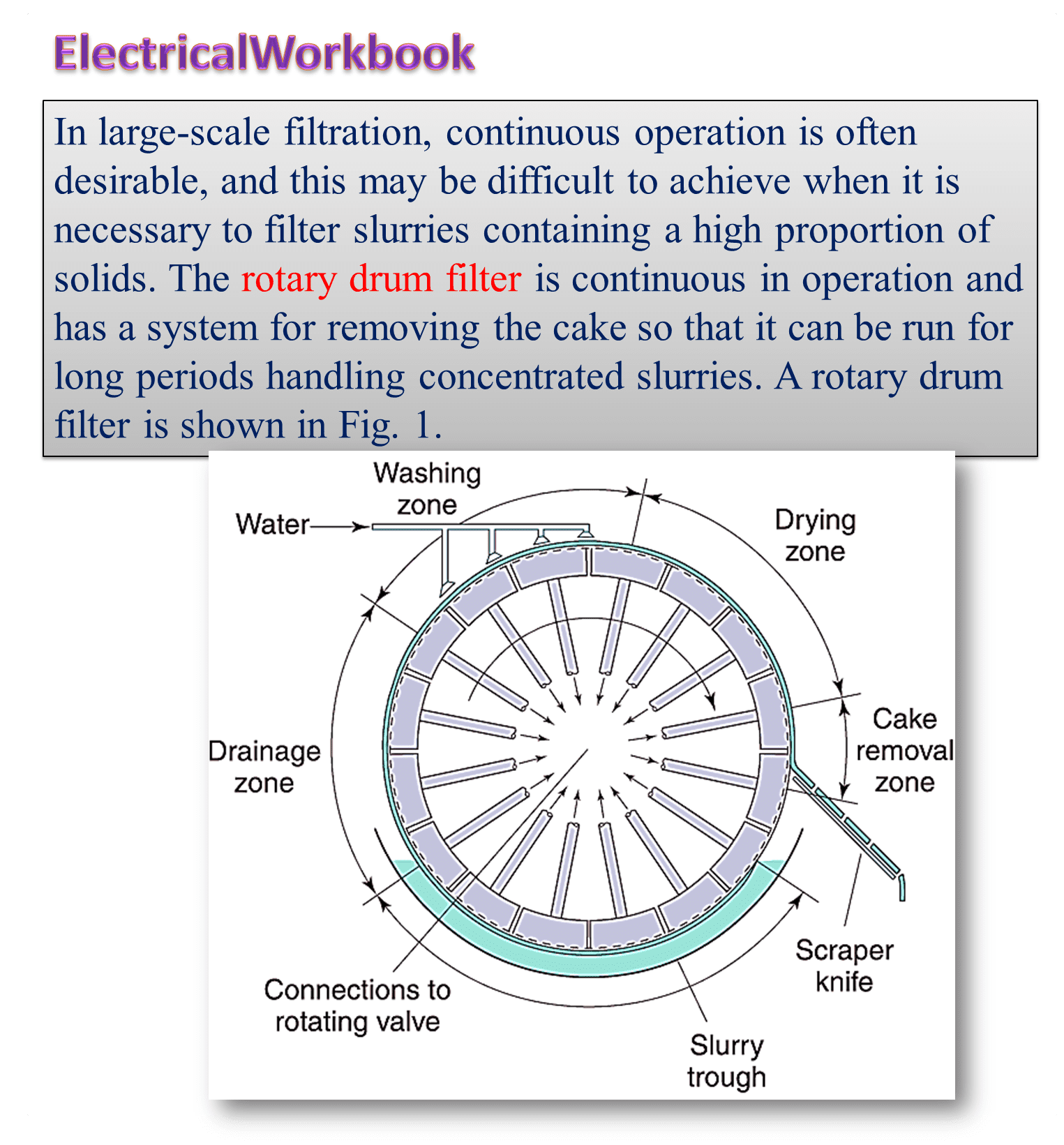
Figure 1: Rotary Drum Filter.
Working Principle of Rotary Drum Filter
Rotary Drum Filter (or Rotary Vacuum Filter) works on the straining mechanism on a rotating drum surface under the vacuum.
Construction of Rotary Drum Filter
Rotary Drum Filter consists of two concentric cylinders with annular space divided into separate compartments by radial partitions. The outer cylinder is perforated and covered with a filter cloth. Drum may be up to 2 m in diameter and 3.5 m in length giving an area of 20 m2. The region between the two cylinders is divided longitudinally into several sections.
Each section is connected to a rotary valve via an internal pipe to one hole in the rotating plate of the rotary valve. The drum is immersed in a semi-cylindrical tank containing slurry and is agitated to prevent the sedimentation of solid particles. The drum rotates at low speeds i.e., less than one rotation per minute, hence each section passes through the various zones.
Working of Rotary Drum Filter
The following steps take place during each rotation.
Cake Deposition
When the drum is rotated, it enters into the slurry in the trough. Vacuum is applied in this section so that solid is build up on the filter cloth surface.
A cake of desired thickness is produced by adjusting the rotation speed of the drum. Increased speed causes higher rate of filtration and leads to thin cake formation. The filtrate passes through the filter medium into an internal pipe and reaches the receiving tank.
Draining of Filtrate
As the drum leaves the slurry section, it enters the drainage zone where excess filtrate is drawn inside. Here, special cake compression rollers are included, so that the cake is compressed and at the same time it retains a minimum amount of filtrate, which also improves the efficiency of washing and drying process.
Washing of Cake
Here, water is sprayed on the cake to remove traces of filtrate retained by it. A separate vacuum system is applied on the panel to suck the wash liquid. Wash water is collected into a separate collecting vessel.
Dying
Here, hot air is blown onto the cake to dry it and hence the moisture content of the cake is reduced to 1%.
Cake Removal
Pressure is applied under the cloth to aid in cake removal. Then, the cake is removed with the help of a doctor knife and conveyed to a receiver. Now the drum is ready to receive a fresh slurry. The above mentioned process is continued till the slurry gets exhausted.
Advantages of Rotary Drum Filter
- Continuous operation is possible.
- Labour costs are very low due to automatic and continuous operation.
- It has a large capacity.
- Simultaneous removal of cake is possible while the operation proceeds. Hence, suitable for the filtration of concentrated suspensions.
- Cake of any thickness can be built up by altering the speed. For solids that form an impenetrable cake the trickiness may be limited to less than 5 mm, while for coarse solids forming porous cake, the thickness may be 100 mm or more.
- Washing as well as drying is done simultaneously.
Disadvantages of Rotary Drum Filter
- It is very expensive.
- Complex piece of equipment with reverse moving parts.
- It requires extra equipment such as vacuum pumps, vacuum receiver and traps, slurry pumps and agitators.
- The drying and washing processes are made inefficient due to the drawing of air (through vacuum system) which causes cracks.
- In case of solids forming impermeable cake, it is less satisfactory.
- Obtaining a dry cake is difficult.
Applications of Rotary Drum Filter
- Suitable for the filtration of suspension containing high solid content.
- Calcium carbonate (CaCO3), magnesium carbonate (MgCO3) and starch can be collected.
- Separation of mycelium (cell mass) from the fermentation liquor. E.g.: Penicillin extraction